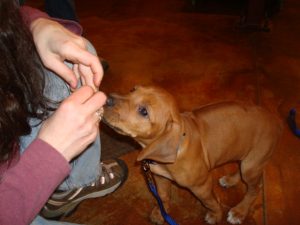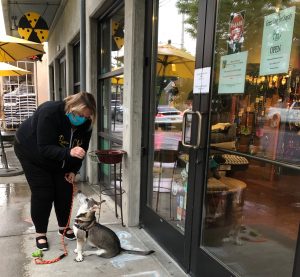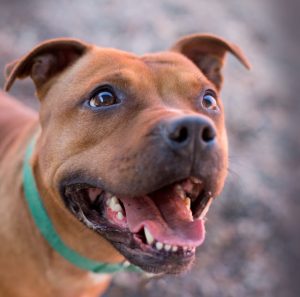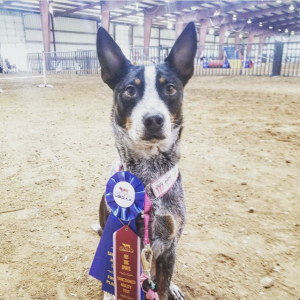
Photo by Heather Ohmart
(Foundational Thinking For Creating Good Behavior In Dogs Part Three)
A lot of people worry about training with treats.
- * Do I have to keep giving them treats for everything for the rest of their lives?
- * Aren’t I bribing them?
- * I want them to do things because they want to please me.
- * I want them to do things right away and I don’t want to have to show them a treat to get them to listen.
These are all good questions.
Tiny high value treats are a great way to teach new behaviors to any animal.
Learning something new can be challenging for all of us, and for dogs it can be both physically and mentally challenging. It can also be emotionally challenging for them when working on behaviors that will help them combat the discomfort or outright fears they might have about strangers or dogs or loud noises, etc. Yummy treats can make those more difficult things easier, and the fact that they’re sprinkled though the activity fairly regularly and appear when they do the best job can be very motivating to try harder to make that good thing happen. Please read more about the value and science behind positive reinforcement training and how dogs learn, and the dangers and outright misinformation surrounding dominance based training in our last blog post: To Treat or Not to Treat
The greatest benefit to using treats when teaching a new behavior is how quickly you can teach something new if you’re using them, as the dog is usually trying to figure out how to get those neat treats, and may stay in the game longer before she gets frustrated. By quickly rewarding small advances towards your end goal, she can get the picture of what you’re after and get there faster. This is helpful to you, the trainer, and also helpful to your relationship. If you’re asking her for a new behavior she’s never heard of before, don’t forget that you have to show her what you want her to do. It seems like an obvious statement, but they really don’t speak English right away.
Picture this: If your boss (who maybe has a bit of a short fuse, so you’re already a little anxious about doing the wrong thing) says in a demanding voice, “Zowzy!” And points at the wall, you’re not going to know what the right answer is to that request. There are certainly a lot of wrong answers and likely only one right one, and if you tried one of the wrong ones (maybe you just looked at the wall, or went over to the wall and looked at a framed picture) and he seemed to be upset by that and he says “Zowzy!” even louder, your anxiety level might climb. It just wouldn’t be an efficient way for you to figure out what he wants, and you probably won’t enjoy figuring it out. Repeating a word they don’t know in a louder voice certainly won’t make them know what to do.
With treats, we can “lure” them towards the behavior we want, in order to establish what you’re after, and don’t worry – we can then phase out the lure. Small treats allow you to be able to get a lot of voluntary repetitions of the new behavior quickly, keeping the dog engaged and therefore learning what it is you want.
So the scenario of teaching a dog to sit might go like this:  the dog is standing and you put a treat right up to her nose (even touching her right under her nose with it, and move it up and back slowly so she’s following it. This makes her head point up towards the ceiling, and she might start to sit “by accident” because she’s following that treat. When her butt touches the floor, say “yes!” right at that moment and give her the treat and praise her. Do it a few more times the same way. Now it might be getting faster, as she’s starting to realize that when she gets into that position, she gets a treat. Now you can start saying the word “sit” right when you bring the treat to her nose. After a few repetitions, she’s going to start to build an association with the sound of the word sit, that it predicts that you’re going to be doing the thing where her butt touches the ground. End the session on a high note.
the dog is standing and you put a treat right up to her nose (even touching her right under her nose with it, and move it up and back slowly so she’s following it. This makes her head point up towards the ceiling, and she might start to sit “by accident” because she’s following that treat. When her butt touches the floor, say “yes!” right at that moment and give her the treat and praise her. Do it a few more times the same way. Now it might be getting faster, as she’s starting to realize that when she gets into that position, she gets a treat. Now you can start saying the word “sit” right when you bring the treat to her nose. After a few repetitions, she’s going to start to build an association with the sound of the word sit, that it predicts that you’re going to be doing the thing where her butt touches the ground. End the session on a high note.
Next you’ll want to start the process of phasing out the lure, but we want her to have a solid sit before we eliminate it altogether. Here’s how: In the next session, repeat what you did before a few times. Your next step will be to hide the treat a little in your hand. Eventually you might like to have a hand signal to ask her to sit (many people might be surprised to find out that dogs generally respond even better to hand signals than to voice commands, maybe because we’re always talking at them). I like to use my flat hand, palm towards ceiling, and bending my elbow. It kind of mimics the up and back luring motion you just did. You can make this hand signal by putting the treat under your thumb on your flat hand. Let her sniff it there, say sit and then move that flat hand up and back just like you did before. When her butt touches floor, say “yes!” and give her the treat (and maybe a second one, for having accomplished something slightly new). Once she’s doing that easily with the treat a little more hidden under your thumb, put the treat in your other hand and use your signal hand the same way you did last time. This time when she sits, you mark the behavior with “yes!” again but the treat comes in from your other hand. This changes the picture so she knows that she still gets a treat at this point even if she can’t see one. End on a high note.
Start to practice this new behavior in new places with the treat still in the other hand. Dogs don’t generalize very well at first, meaning that she might not know that the request for “Sit” will actually be the same behavior in another room, or outside. “But sit means touch my butt to the living room floor – how can I do that somewhere else?” Even if you have to lure the first time or two in a new place, it’s OK. She’ll soon realize that “Sit” means put your butt down, no matter where we are. And then perhaps she’s getting better at doing it when you say it, or maybe when she sees you follow the word sit with the hand signal. You can work on both.
OK – now she’s easily sitting when you ask for it. How do we phase out the treat?
Here’s the best training tip I can give you:
EARN EVERYTHING! Most dogs like a job. In fact, if you’ve adopted a working breed of dog, you should feel pretty much obliged to find activities that challenge their minds and exercise their bodies (think agility or other organized dog sports, freestyle, nose work, lure coursing, etc). Of course all dogs need stimulation and exercise, and any breed might enjoy these activities! Another way to always be sharpening their training skills (and yours) and to give them a job to do is to incorporate training throughout their day in a simple way that doesn’t take up a lot of time for you, but gives you great benefits.
The thing about positive reinforcement training is that it doesn’t mean you have to be permissive, or that they can have anything they want any time they want it, and it certainly doesn’t have to have anything to do with bribery, or that you have to have treats on you to get what you want from them. Here’s the way to get them to do what you want, the first time you ask:
Once your dog learns a new behavior like sit, and really knows it well, even in new areas and with a little bit of distraction around, you can ask them do this behavior to earn the things in life they want. Any time they’re excited to do something, or want to get to something or someone, or you want to give them something like a new toy or chew, this is your opportunity to get them to earn it.
Leadership is important to dogs. This does not mean “dominance” or having them do things you say to avoid punishment. What it means is that you, the leader, controls all of their resources. They have to go through you to gain access to these resources, and you have the power to give or withhold access to them. This kind of leadership is actually quite a bit more powerful than the threat of force. You are not the impediment to them getting these resources, you are the gateway. They can actually speed up their own access to these resources by doing what you want as soon as you ask them. They can also choose to not do what you ask and lose access to the thing they want (oooh – powerful stuff). Here are a few examples to illustrate what I mean:
Scenario #1:
Lets say your dog loves to go for a ride in the car. (Remember, you’re going to use this tactic only with things they want. If your dog is frightened of the car, you won’t want to make them work for access to something they fear). You’ve worked on “Sit” a lot, and the dog has a solid understanding and pretty much does it when you ask, no matter where. You’ve put the leash on and asked “Do you want to go for a ride?” and your dog is stoked! He can’t wait to get in the car. You go out to the car together, and you say “Sit”. You’re going to say it once, and not repeat it. (saying “Sit. Sit! Sit! Come on, Sit!” only dilutes your cue, making is less meaningful.) If the dog sits, super! Immediately give him access to the car and tell him he’s great. More likely what might happen is that he doesn’t. When something is exciting, it’s harder for them to do what you ask the first time you ask them. If he didn’t sit, say “Oops, Too Bad!” And turn right back around and take him back into the house. Wait a moment or so, and then ask again if he’d like to go for a ride. Repeat what you did before (go to the car and ask for a sit), and still be willing to put your money where your mouth is and go back to the house. What you’re after is a dog that knows he has this one window of opportunity to get what he wants, and as soon as he does it, he gets what he’s after. I’ll just bet you the next time you say sit to get into the car he does it! When he does, don’t give

Earning the right to come into Green Dog. Good Job Rita!
him a treat, just say “Yes!” and let him right into the car. He did what you asked, he got what he wanted. It’s likely that the next time you ask for a sit to get into the car, he’ll do it, the first time you ask. Keep your standards high (but of course allow for strange circumstances like a dog hanging out of a window barking at your dog in the parking space next to you) and you’ll get a dog that is on his way to doing what you ask the first time you ask him.
Scenario #2:
Your dog loves to meet other dogs. She’s straining at her leash when she sees a dog coming towards her on a walk. In this situation, you are usually just an impediment to her, keeping her away from what she wants. This isn’t great, as she’s not only building excitement and frustration, she might also be making the approaching dog uneasy or overly excited too. If she gets to meet the dog when she’s dragging you, this reinforces that straining at the leash behavior. You’ve basically just told her, “If you really want to get to that dog, all you have to do is drag me there”. She shouldn’t be blamed for this bad behavior, as she’s only doing what works. With any behavior you don’t like, ask yourself: What do you wish she would do? Wouldn’t you like it if she sat down and looked to you for permission to greet? This is possible!
Before you’re too close to the other dog, ask if their dog would like to say hi. If the answer is no, then ask your dog to turn away and come with you, using your treats to reward breaking away from the exciting dog and coming with you. (This is a really good treat moment).
If the owner says OK, then this is a good Earn Everything moment. Say “Great – just give me a minute because she has to sit first”. This gives you a moment to work on this. Step in front of your dog, facing her and essentially blocking access for a moment. Get her attention, and ask for a”sit”. She probably won’t, she’ll likely be trying to get around you. Don’t make a big deal, just say “Oops – too bad” and walk her a little bit back. (Space penalty). Not sitting got you a little farther away, not closer. Still blocking her, ask for a sit again. Repeat the “Oops too bad!” and the space penalty backup if you have to. Hopefully, your next “Sit” will get her to touch her butt down, even for a second. As soon as she does, you release her with “Yes! Go say Hi!” and let them say hi right away. You want to reinforce this amazing skill! The first time might be messy, but the next time might go a bit better. If you’re consistent with this, you will soon have a dog that when she first sees a dog, instead of just charging forward to get to the dog, you start to have a dog that sees another dog and whips her head around to look at you and puts her butt on the ground, as if saying, “Dog there! Oh Please can I say hi? Look! I’m sitting!” You will no longer be the impediment to her joy – you are the gateway through which she has to pass to get it, and you are very happy to let her have what she wants if she does what you ask right away. She’s finding her way to get what she wants even faster, so a faster response is what will be reinforced.
Scenario #3:
You can use other rewards he likes to reward a behavior you’re working on. Let’s say you’ve been working on “Come” recently. You’ve just gotten home from a trip to Green Dog and you’ve bought a new stuffed animal for your dog (Thanks!). Don’t just walk into the house and say here’s a new toy! Instead, hide that toy in the waistband of your pants, call the dog to “Come!”, and when he runs to you, say “Yes!” when he gets there and surprise him with the new toy! Don’t waste an exciting new bone by giving it to him for free. Ask him for a sit or a down or a spin and then surprise him with it. You’re not waving the bone in front of him as a bribe, you’re reinforcing him for doing what you ask. Even if you are holding something up you intend to give him like his food bowl, make him work for it by asking for a few different behaviors in a row, or work on “wait” when you put it down. You are the bearer of great things. You are the portal to fun and sustenance. This is a more effective form of power, and your relationship only gets better for it.
Just make sure that any behavior you’re asking for is fair – that it’s not something he hasn’t practiced or that it’s not in a stressful new situation. Once behaviors are solid, you don’t need big training sessions every day if you sprinkle these behaviors into your daytime to make him earn things he wants and make those behaviors more solid – “Lay down” to get dinner. “Sit” to go out of the house. “Spin” to get into the dog park gate.
Do use treats to help them trust strangers, to desensitize them to the sound of the scary dump truck, to reinforce important behaviors like “leave it”, (and use extra jackpot treats for leaving something amazing). Keeping a treat-filled training pouch on you for walks is an especially good idea for a young dog, or a fearful dog. Do reinforce the things you want your dog to be better at, and they will be.
Of course dogs like to please their owners. That’s one of the many reasons we love them. Your praise and approval can be very reinforcing for most dogs. But the truth is that all animals and people tend to learn what gets them what they want or need faster, and abandon the tactics that don’t work as well. Working with this construct can get you the dog you always wanted. One who looks to you for permission. One who does what you want when you ask them to. A dog that you don’t have to bribe to get them to listen. And above all a dog who trusts you and looks to you for guidance.
This article is part of a series about training puppies/adult dogs (and even tips for cats). Here are links to the others so far:
Tips for New Puppy Owners What a fun time you’ll have! We very much want your new baby to live a long, healthy, happy life, so we thought we’d compile some of the nitty-gritty dos-and-don’ts of puppy care. Socialization, nutrition, our favorite chews, tips on potty training, etc!
Raising a Puppy (Or Any New Dog) During Covid 19 This new-puppy-during-quarantine situation does come with a few unique challenges like socialization and avoiding separation anxiety when you go back to work.
What Do They Want? How Should They Get It? (Foundational Thinking For Creating Good Behavior in puppies and kittens! Part One) Often we hapless humans try our best to tell our puppies (and kittens) what we want them to do or especially not do, yet the bad behaviors increase and we struggle to get them to be what we wish they would be, especially when it comes to attention-getting behaviors. I’m here to offer a few rules of thumb for most any behavior you don’t like.
To Treat Or Not To Treat? (Foundational Thinking For Creating Good Behavior In Dogs Part 2 : Choose Your Methods of Training Carefully, especially with Reactive/Fearful Dogs.) Once you understand how dogs think and learn, and the concepts behind why you use certain methods, you can train just about any behavior you like! I think it contains what I believe to be some of the most important information I can give you about why we use positive reinforcement, and the dangers of using dominance theory and aversive methods especially when dealing with situations that are uncomfortable for dogs.
Drop It!
We’re continuing our puppy series with discussions of common training challenges. It’s so easy to accidentally create a dog that runs away from you when they get a hold of something they shouldn’t have. Wouldn’t you rather they spit something out of their mouth when you approach? You can do it!
Come!
The “Come!” command is one of the very most important things we can teach our dog. A reliable recall is imperative to get them quickly to safety, to recover them if they happen to get out the door, and to proactively remove them from a situation at the dog park that might evolve into trouble. It’s also a wonderful luxury when you are in a safe quiet place to be able to have your dog off leash and know you can get him right back when you want to. Like the command “Drop It!”, it’s easy to accidentally make mistakes when training this behavior that can undermine your success. Here’s how to succeed in training a reliable recall.


